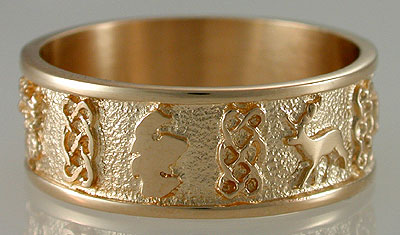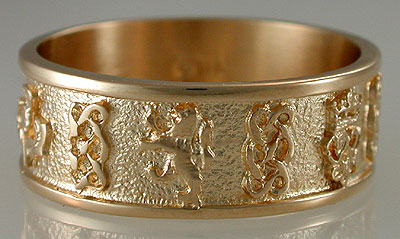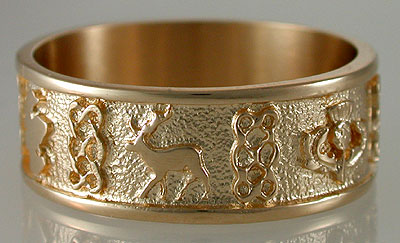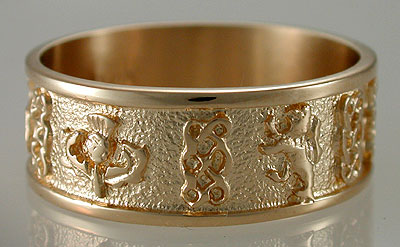Scotland History Heritage ring
History of Scotland as told on a 14kt Heritage ring from Scotland. The width is 8mm and thickness 1mm. The background is a textured finish with the designs raised above. Perfect for a wedding band or ring to be noticed.
The designs are bagpipes, map of Scotland, Stag, Scottish Thistle, Lion Rampant, Luckenbooth and each design is spaced with a Celtic knot of continuity, the talisman of longevity.
History of Scotland Heritage ring is only made in the sizes listed. They are made in the Orkney Islands to the sizes and standards of the people of Scotland. The chart in the dropdown box shows the USA size by number with the corresponding letter size used in Scotland/Ireland/UK. These are the ONLY sizes the manufacturer will make in. They are a special order made for the Scotland market and not the USA market.
#OR145 - $1,295.00 RETIRED



Bagpipes - This ancient wind instrument has been famously identified with Scotland, and is found in cultures all over the world. The unique sound has stirred the hearts of Scots through the ages - marching into battle, mourning the fallen and evoking memories of home and romance to ex-patriot and descendant Scots everywhere.
Map of Scotland - This map is the shape of Scotland, showing its coastline and the border with England - emphasizing that Scotland has a separate national identity within the United Kingdom.
Stag - Known as 'Monarch of the Glen' - these wild deer roam the highlands of Scotland, and the stags with their massive antlers often look as if they are kings of all they survey, standing proudly on the high ground sensing their surroundings.
Scottish Thistle - The thistle was used by the early Kings of Scotland as their personal heraldic crest and is borne by the Arms of the Realm and by a number of ancient Scottish clans and families as part of their coats of arms. In 1687 James II instituted the Order of the Thistle as a distinct Scottish Order of Knighthood. This order is now one of the oldest of all surviving British orders.
Lion Rampant - The ruddy lion rampant in his field of treasured gold has been the Royal Arms of the Kings of Scotland since the days of Alexander II. The treasured lion still retains its individual status as a sovereign coat of arms and continues to play an important role in symbolizing Scots Heraldry.
Luckenbooth - Hearty shaped brooches, in vogue in the early 1700's were traditionally exchanged between lovers on betrothal and subsequently pinned to the baby's shawl to protect the child from 'evil spirits'. The name comes from their sale in Luckenbooths around St Giles Cathedral on the Royal Mile in Edinburgh.
Celtic Interlacing Knotwork - Celtic knotwork interlacings were popular in the Pictish School of Celtic Art. As a symbol of continuity, these interlacings represented by one continuous line, symbolize the hope of eternal life and have come to be accepted as a talisman of longevity.
Back to Scottish jewelry
HOME | order faqs | order form | gold faqs | chains | customer comments |
IRISH CELTIC JEWELLERY index ~ FINE JEWELRY index ~ MARINE LIFE index ~ NAUTICAL JEWELRY index

